Colorful primroses ring in the garden year. But not all primroses are the same. We show the diversity of the primrose species and explain the differences.

The pillow primrose (Primula vulgaris) is the best-selling type of primrose and awakens the first fever of spring with its friendly appearance. But the genus of the primroses is much more diverse. We have selected 11 particularly pretty and diverse primrose species to give you an insight into an undreamt-of range of growth forms as well as flower colors and shapes.
contents
- Primrose species: how many are there and where do they come from?
-
The most beautiful primrose species
- Alpine auricle (Primula auricula)
- Cup primrose or poison primrose (Primula obconica)
- Common cowslip (Primula veris)
- Bunk primroses (Primula beesiana, Primula japonica and Primula bullesiana hybrids)
- Lilac primrose (Primula malacoides)
- High cowslip (Primula elatior)
- Cushion primrose (Primula vulgaris)
- Ball primrose (Primula denticulata)
- Orchid primrose (Primula vialii)
- Rose primrose (Primula rosea)
- Carpet primrose (Primula juliae)
Primrose species: how many are there and where do they come from?
The natural distribution areas of the primrose species (Primula) can be found in almost the entire northern hemisphere. Some species have adapted to life in mountainous regions. These alpine primroses almost always show a pink, red-violet to blue-violet flower, as this is particularly attractive to the pollinators of the mountain regions. Most non-alpine species, however, have yellow flowers. From a total of around 500 primrose species, we would like to introduce you to 11 of the most beautiful primrose species below.
The most beautiful primrose species
In addition to the color of the flowers, the different species also differ in their flowering time, height and shape. The mostly 2 to 25 flowers per inflorescence, which are arranged as umbels or whorls, can be simple, filled or even frilled. If you combine different types of primrose with each other, you can enjoy the flowers from January to July.
Alpine auricle (Primula auricula)
The alpine, wild primrose species Primula auricula is a resident of the Limestone Alps that has now become rare. It becomes about 5 to 25 cm high and blooms between April and June. It forms thick, smooth, hairy leaves and is the only alpine primrose species with light yellow and fragrant flowers. The perennial alpine auricle loves well drained, calcareous soils in shady to partially shaded locations.

Cup primrose or poison primrose (Primula obconica)
The cup primrose, hardy to -5 ° C, is a perennial species of primrose, which should, however, spend the winter indoors. It grows to about 5 to 25 cm high and can start flowering in any month of the year, depending on the variety. The umbel-like arranged flowers can be white, pink or light purple in color. There are varieties with ruffled, double or single flowers. The cup primrose can also be kept as a houseplant all year round. The fine hairs on the leaves and stems release a toxin, the so-called primin, when touched. This can lead to contact allergies and skin rashes, which is why wearing gloves when handling the primrose, which is also known as poisonous primrose Primula obconica is particularly important.
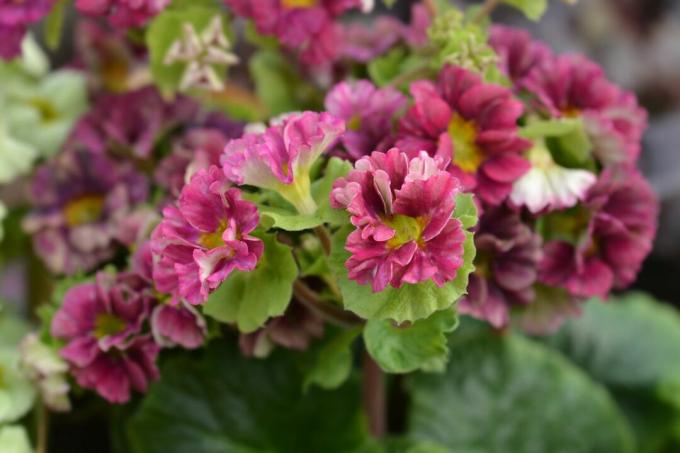
Common cowslip (Primula veris)
The real cowslip or apothecary primrose is a native perennial with a stature height of 10 to 20 cm. The small, tube-like, fragrant flowers that have grown together at the base sit on upright, thick flower stalks. On warm spring days between April and May, bumblebees in particular visit the numerous delicate flowers. Its dark green leaves are wrinkled and oval-shaped, the leaf margin is rolled down. The real cowslip prefers neutral to lime-rich, dry to fresh, humus-rich and well-drained soils. Unlike many other primrose species, the common cowslip thrives in full sun. In addition to the wild forms that bloom exclusively in light yellow, red-blooming varieties such as ‘Red Tones’ are also available.
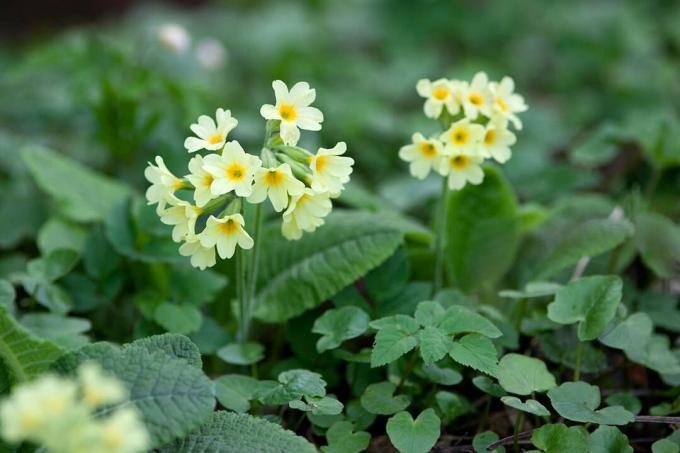
Bunk primroses (Primula beesiana, Primula japonica and Primula bullesiana hybrids)
Plants of the species Primula japonica and Primula beesiana as well as Primula bullesiana x beesiana-Hybrids called. The upright, clumpy, perennial shrubs reach 30 to 60 cm in height, in exceptional cases even around 100 cm. Single-tier primroses form long flower stalks with flower whorls that bloom in layers and are pink, purple, yellow, white or orange-red in color. The hybrids in particular are not particularly long-lived, however, they reproduce in suitable fresh to moist, humus-rich locations by self-sowing. Floor primroses bloom late in the year from June to August. Popular Primula japonica-Varieties are ‘Appleblossom’ and the red flowering Millers Crimson ’.

Lilac primrose (Primula malacoides)
The 30 to 45 cm high, perennial lilac primrose or bridal primrose comes from China and Myanmar. It is an ornamental plant that we cultivate as an annual, but it can be overwintered frost-free indoors. The white or pink to lavender colored flowers sit loosely on long flower stalks. Thanks to cultivation in the cold house, the lilac primrose already blooms from December to March. If you sow the primrose species yourself in autumn on the light-colored windowsill at around 10 to 15 ° C, flowering will not begin until later in March. In the winter months it is placed as a houseplant in a shady to partially shaded location and can be placed outdoors in a cool location from April. However, you should protect them well from late frost.

High cowslip (Primula elatior)
The high cowslip or forest cowslip is a perennial primrose species that is native to us and that occurs in forests. The perennial reaches heights of 10 to 30 cm and shows its umbel-shaped, light yellow flowers with a sunny yellow center between March and May. The high cowslip is ideal for planting under trees and on the edges of forests. It spreads itself by sowing. The ideal location is partially shaded to shady on fresh to moist, loamy, humus-rich soils. The eye-catching gold-fringed primrose is Primula elatior-Hybrid. The dark petals of varieties such as ‘Gold Lace’ are outlined in light to golden yellow and form an exciting contrast.
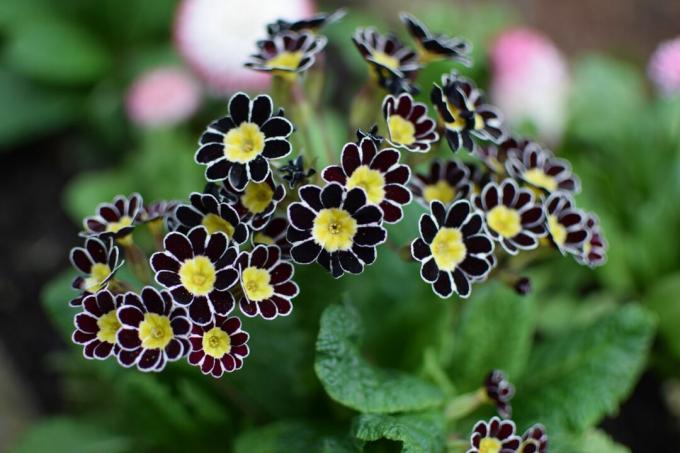
Cushion primrose (Primula vulgaris)
The native perennial pillow primrose, also called upholstered primrose, is hardy and reaches a height of 10 to 15 cm. It has an extremely short flower stalk and close-fitting, large, sun-yellow to light yellow, but also purple and pink flowers. The pillow primrose spreads by self-sowing and forms extensive, loose stands at the right location. Primula vulgaris prefers partially shaded to light shady locations on humus rich soils. It can withstand summer drought and is ideal for underplanting woody and deciduous trees.
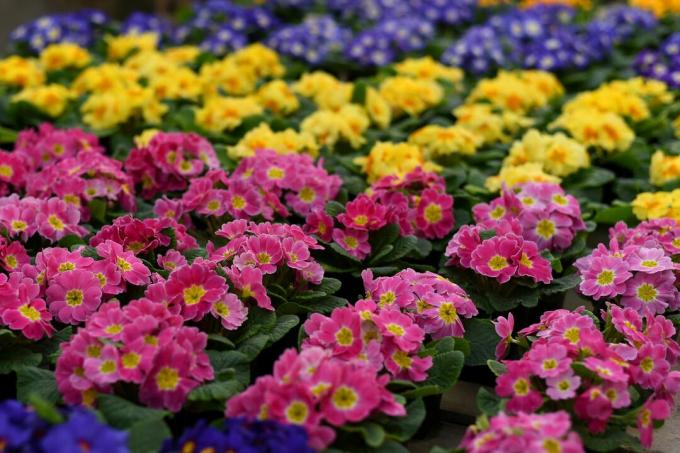
Ball primrose (Primula denticulata)
The hardy primrose becomes about 15 to 30 cm high and blooms between March and May. It forms spherical, round inflorescences from numerous unfilled single flowers on long, hairy stems. The basal leaves only appear when the spherical primrose is in full bloom. The flower color ranges between white, pink and blue-violet, depending on the variety. The spherical primrose prefers fresh to moist, well-drained and humus-rich soils in partial shade. Popular types of primrose are ‘Alba’, ‘Grandiflora’ or ‘Ruby’.

Orchid primrose (Primula vialii)
The perennial, hardy orchid primrose comes from China and is about 30 cm high. The exotic-looking primrose species blooms between May and July. All around on long stems there are numerous tiny, red-violet flowers arranged in narrow cobs in deep red calyxes. The mostly short-lived orchid primrose prefers lime-poor, well-drained, fresh and humus soils in partial shade. The ‘Red Hot Poker’ primrose variety shows particularly large inflorescences.
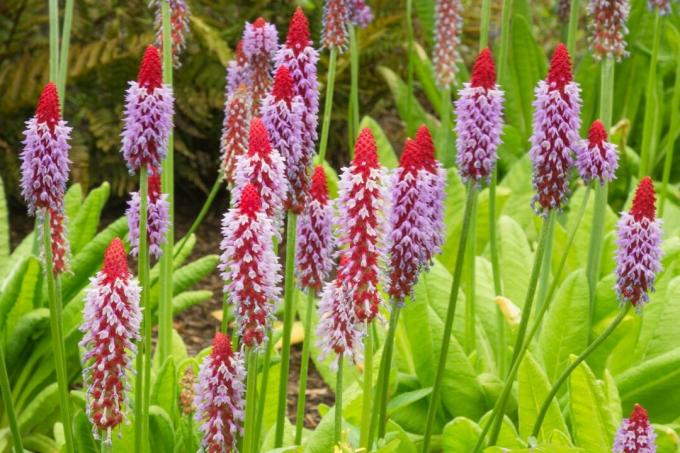
Rose primrose (Primula rosea)
The rose primrose, also known as rose cowslip, is a perennial, hardy species with a stature height of around 20 cm. It is originally from Kashmir and Afghanistan. The cold-sensitive flowers are at risk of late frost, appear from March and are all pink to raspberry-red in color. Hence the allusion of the name to the rose (pink sp.). The flowers, which sit on long stalks and are grouped as a loose grape, appear before the foliage. The rose primrose is ideal for planting wet soils, because it needs moist to boggy, loamy-sandy soils in a sunny to partially shaded location.
Carpet primrose (Primula juliae)
The low carpet primrose comes from the Caucasus, is just 5 to 10 cm high and is particularly suitable as a ground cover. The perennial, hardy perennial flowers from February to April. It forms large, solitary purple-red to mauve-blue flowers with a yellow center. Carpet primrose prefer a permeable, moist, but never waterlogged soil with an acidic to neutral pH value in partial shade. Popular carpet primrose varieties are the violet ‘Blue Horizon’, ‘Wanda’ with pink flowers or the light blue Blue Julianas ’.
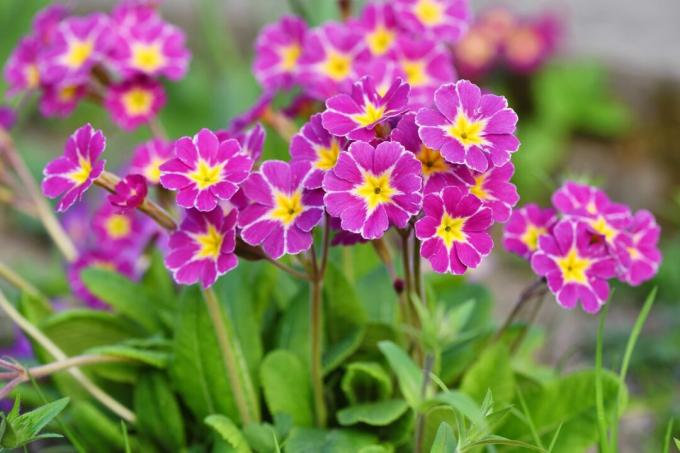
Have you decided on a type of primrose? Then here you will find instructions and tips for Planting and caring for primroses.
